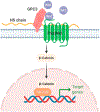Glypican-3: A molecular marker for the detection and treatment of hepatocellular carcinoma☆
- PMID: 33384879
- PMCID: PMC7771890
- DOI: 10.1016/j.livres.2020.11.003
Glypican-3: A molecular marker for the detection and treatment of hepatocellular carcinoma☆
Abstract
Hepatocellular carcinoma (HCC) is a malignant tumor with a fairly poor prognosis (5-year survival of less than 50%). Using sorafenib, the only food and drug administration (FDA)-approved drug, HCC cannot be effectively treated; it can only be controlled at most for a couple of months. There is a great need to develop efficacious treatment against this debilitating disease. Glypican-3 (GPC3), a member of the glypican family that attaches to the cell surface by a glycosylphosphatidylinositol anchor, is overexpressed in HCC cases and is elevated in the serum of a large proportion of patients with HCC. GPC3 expression contributes to HCC growth and metastasis. Furthermore, several different types of antibodies targeting GPC3 have been developed. The aim of this review is to summarize the current literatures on the GPC3 expression in human HCC, molecular mechanisms of GPC3 regulation and antibodies targeting GPC3.
Keywords: Glypican-3 (GPC3); Hepatocellular carcinoma (HCC); Wnt signaling.
Conflict of interest statement
Declaration of competing interest The authors declare that they have no conflict of interest.
Figures


Similar articles
-
Glypican-3 is a prognostic factor and an immunotherapeutic target in hepatocellular carcinoma.World J Gastroenterol. 2016 Jan 7;22(1):275-83. doi: 10.3748/wjg.v22.i1.275. World J Gastroenterol. 2016. PMID: 26755876 Free PMC article. Review.
-
Glypican-3: a marker and a therapeutic target in hepatocellular carcinoma.FEBS J. 2013 May;280(10):2471-6. doi: 10.1111/febs.12126. Epub 2013 Jan 31. FEBS J. 2013. PMID: 23305321 Review.
-
Glypican-3: A promising biomarker for hepatocellular carcinoma diagnosis and treatment.Med Res Rev. 2018 Mar;38(2):741-767. doi: 10.1002/med.21455. Epub 2017 Jun 16. Med Res Rev. 2018. PMID: 28621802 Review.
-
GPC-3 in hepatocellular carcinoma: current perspectives.J Hepatocell Carcinoma. 2016 Nov 8;3:63-67. doi: 10.2147/JHC.S116513. eCollection 2016. J Hepatocell Carcinoma. 2016. PMID: 27878117 Free PMC article. Review.
-
The significance of glypican-3 expression profiling in the tumor cellular origin theoretical system for hepatocellular carcinoma progression.J Gastroenterol Hepatol. 2017 Aug;32(8):1503-1511. doi: 10.1111/jgh.13736. J Gastroenterol Hepatol. 2017. PMID: 28087980
Cited by
-
Alpha-fetoprotein, glypican-3, and kininogen-1 as biomarkers for the diagnosis of hepatocellular carcinoma.Int J Clin Exp Pathol. 2024 Nov 15;17(11):383-395. doi: 10.62347/QSII4050. eCollection 2024. Int J Clin Exp Pathol. 2024. PMID: 39660335 Free PMC article. Review.
-
Construction of GPC3-modified Lipopolymer SiRNA Delivery System.Curr Pharm Des. 2024;30(19):1507-1518. doi: 10.2174/0113816128258852231204102044. Curr Pharm Des. 2024. PMID: 38644723
-
Testosterone, β-estradiol, and hepatocellular carcinoma: stimulation or inhibition? A comparative effect analysis on cell cycle, apoptosis, and Wnt signaling of HepG2 cells.Naunyn Schmiedebergs Arch Pharmacol. 2024 Aug;397(8):6121-6133. doi: 10.1007/s00210-024-03019-5. Epub 2024 Feb 29. Naunyn Schmiedebergs Arch Pharmacol. 2024. PMID: 38421409
-
Fetal gut cell-like differentiation in esophageal adenocarcinoma defines a rare tumor subtype with therapeutically relevant claudin-6 positivity and SWI/SNF gene alteration.Sci Rep. 2024 Jun 12;14(1):13474. doi: 10.1038/s41598-024-64116-2. Sci Rep. 2024. PMID: 38866822 Free PMC article.
-
Molecular pathogenesis and systemic therapies for hepatocellular carcinoma.Nat Cancer. 2022 Apr;3(4):386-401. doi: 10.1038/s43018-022-00357-2. Epub 2022 Apr 28. Nat Cancer. 2022. PMID: 35484418 Free PMC article. Review.
References
-
- Centers for Disease Control and Prevention. Wide-ranging online data for epidemiologic research (WONDER). Underlying cause of death output based on the Detailed Mortality File. https://wonder.cdc.gov/. Accessed Aug 2, 2020.
-
- Villanueva A Hepatocellular carcinoma. N Engl J Med. 2019;380:1450–1462. - PubMed
-
- Ronot M, Bouattour M, Wassermann J, et al. Alternative Response Criteria (Choi, European association for the study of the liver, and modified Response Evaluation Criteria in Solid Tumors [RECIST]) versus RECIST 1.1 in patients with advanced hepatocellular carcinoma treated with sorafenib. Oncologist. 2014;19:394–402. - PMC - PubMed
